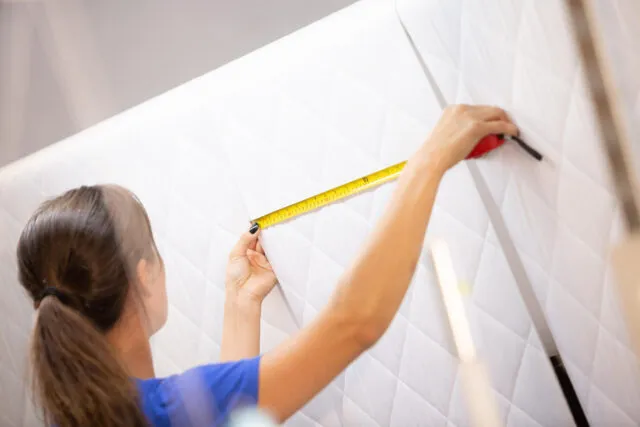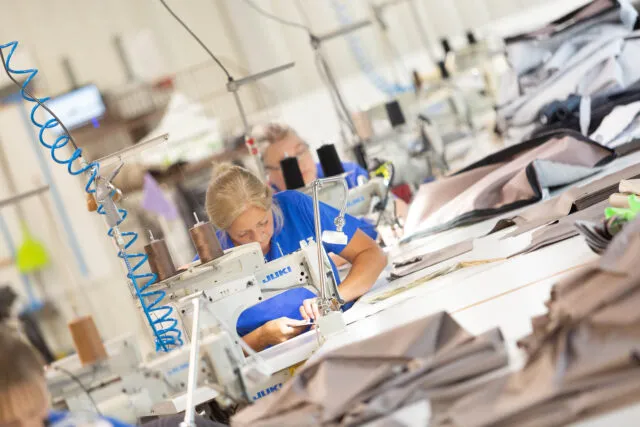Each order is a new challenge. Interview with Andrzej Wiśniewski, Logistics Specialist and Head of the Cutting Department
Each production process begins in the cutting room and warehouse. These two departments are the responsibility of Andrzej Wiśniewski, who efficiently manoeuvres between orders and the demand for materials in each department, effectively supervising the processing capacity in the cutting department. What are the biggest challenges in his work and how does he reconcile supervision over two departments at Bartex? Find out.

Andrzej, let’s start with the cutting room, because it is one of the most important departments in our production. What exactly is going on there?
The cutting room is the first stage of sewn products – it is where the whole process begins and that is why it is so important. We mainly cut bedding and pillows, sheets, and tablecloths here. At the same time, it is a small department and drives the work of a large number of people. There are three operators here in three shifts and the work of people at the next stage of production, i.e. at the sewing room, depends on them. There we have a 30-person team to whom we provide materials in appropriate dimensions for further processing.
Is the work in the cutting room fully automated? What devices do you work on?
We use automated lines for cutting fabrics: VectorFurniture Q25 by LECTRA, synchronized with spreading machines from Brio, which allow spreading without tension. On these lines, the effective width of the cutting area is 182 cm, but we also have a BULLMER spreader for cutting fabrics from rolls and pallets with a maximum width of 320 cm.
Thanks to such high automation, we have a large processing capacity and we are ready to accept any order. We also offer our customers the option to cut the rolls to size, so they don’t have to do it themselves before delivering them to us. This is a great help from the point of view of the person ordering sewing services.
Automation also provides high repetition, but doesn’t that make the work itself repetitive? Is there anything else that can surprise you in the cutting room when it comes to orders or materials?
Whenever we decide that nothing will surprise us anymore, a new order comes in that verifies it (laughs). In fact, our work is characterized by low repeatability, contrary to what it might seem to outsiders. Each bedding is a different pattern and a different type of material. Customers come up with new products all the time, and we have to analyze each such novelty. Because you have to remember that each material behaves differently and this is influenced not only by the type of fabric but also by other factors. For example, transportation. The material can change its properties under the influence of humidity or other climatic conditions. So if it comes from China and spends several months in a container, when it reaches us it will behave differently than when it was wound on beams. We have to take that into account.
If we are talking about products such as bedding, tablecloths or sheets, it is certainly important to follow hygiene rules.
Definitely. Each product is most often packed in our sewing room at the final stage, so it must be clean because it goes directly to the store shelves and is sold to the target customer. Therefore, we follow the rules of hygiene and cleanliness at every stage of production. As for the cutting room, our spreading machine is a new machine, it’s a year old, and it’s clean. It is regularly inspected and maintained. As for the material itself, it is also well protected, because each beam is delivered to us in a package, in a bag or in foil.
You are the manager of the cutting room department. Tell us what exactly the job involves.
I set up a production plan for the needs of the sewing room and prepare products for release according to the needs of the cutting room. These are my most important tasks – I have to make sure that both departments have something to do.
To make our work easier, we divided the work of the warehouse so that it takes care of the needs of the sewing room on the first shift, and the quilting and cutting department on the second shift. And that works for now.
Now that we have moved smoothly to the warehouse, what are your duties as a Logistics Specialist?
In-warehouse logistics is all purchases, deliveries, shipments and inter-warehouse movements, movements between the warehouse and production. All this goes through me and I am responsible for the smooth running of these processes. Also in terms of documentation and supplies – I order materials, settle deliveries and shipments, and settle invoices.
You have many responsibilities, but you’re doing great. What is the biggest challenge for you in your work?
Taking care of the efficient organization of work and the involvement of the right number of people. When we receive a delivery of materials, they are usually containers from China, containing 250 beams. You need to organize people who will unload these beams, you need to sort them and prepare them in the warehouse so that everything is in the right order, and ready for production.
Our internal system helps us with this – managers enter their needs and we adapt to these guidelines. Managers of individual departments can then check whether their needs are already met and whether they can proceed with their work.
And what gives you the greatest pleasure at work or under what conditions do you work best?
It is best when the plan is laid out and I tick off the next projects on a regular basis. Paradoxically, however, the greatest stress occurs when the warehouse is empty. Everyone is snatching jobs from each other because every department wants something to work on. We then need to meticulously distribute the material and act quickly. When we have excess work and high occupancy, then we can choose between orders so as to optimize work in production, avoiding too many machine changeovers and material rotations. Work is more comfortable then.
In this case, we wish you a full warehouse and lots of materials to work with! Thank you for the interview.
Thank you.

Quilting fabrics – how does it affect the functionality of the mattress and bedding?
Professional techniques of sewing and textile manipulation, such as quilting, are used whenever we want to ensure the high quality, ergonomics and durability of each product. How does the quilting process work and what are the benefits? Let's find out.

BARTEX company with Forbes Diamond 2022
We are proud and pleased to announce that Bartex was rewarded with Forbes Diamonds 2022 in the category "revenue from 5 to 50 million".